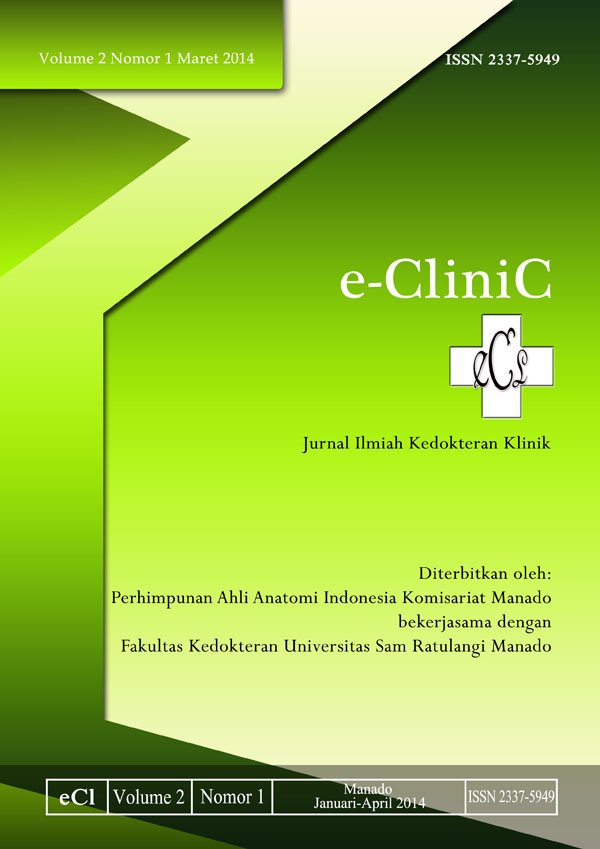ANGKA KEJADIAN KOMPLIKASI INTRAKRANIAL PADA PENDERITA HIV/AIDS YANG DI RAWAT INAP DI BAGIAN NEUROLOGI RSUP PROF. DR. R. D. KANDOU MANADO PERIODE JULI 2012 – JUNI 2013
DOI:
https://doi.org/10.35790/ecl.v2i1.3656Abstract
Abstract: Human Immunodeficiency Virus (HIV) is virus that causes Acquired Immunodeficiency Syndrome (AIDS), which is a retrovirus disease that characterized by the severe immunosuppression that cause opportunistic infection, secondary neoplasm and neurologic manifestations. Nervous system involvement in HIV infections may occur directly through the virus and indirectly as a result of opportunistic infections due to immunocompromised. This study aimed to determine the incidence of intracranial complication in HIV/AIDS patients who were hospitalized in Neurology Ward of RSUP Prof. Dr. R. D. Kandou Manado from July 2012 to June 2013. This study were a retrospective descriptive study using medical record of patients with HIV/AIDS. The results showed there were 36 patients with HIV/AIDS and 27 patients had intracranial complications. Tuberculous Meningitis was the most common type of complications with percentage (51,9%). Based on those 27 HIV/AIDS patients with intracranial complication, patients who were 25-34 years old (44%) have the most intracranial complication. Based on the gender percentage, it is dominated by male (59,3%) and based on the occupations, it is commonly came from entrepreneurs (29,6%). Conclusion: The incidences of intracranial complication in patients with HIV/AIDS were quite high on Tuberculous Meningitis, and it is dominated by male. The highest distributions were found on aged 25-34 whose occupation were entrepreneurs.
Keywords: Intracranial Complication, HIV/AIDS, patients.
Â
Â
Abstrak: Human Immunodeficiency Virus (HIV) merupakan virus yang menyebabkan penyakit Acquired Immunodeficiency Syndrome (AIDS) yaitu suatu penyakit retrovirus yang ditandai dengan imunosupresi berat yang menimbulkan infeksi oportunistik, neoplasma sekunder, dan manifestasi neurologis. Keterlibatan sistem saraf pada infeksi HIV dapat terjadi secara langsung karena virus tersebut dan tidak langsung akibat infeksi oportunistik akibat imunokompromis. Penelitian ini bertujuan untuk mengetahui angka kejadian komplikasi intrakranial pada penderita HIV/AIDS yang di rawat inap di Bagian Neurologi RSUP Prof. Dr. R. D. Kandou Manado selama periode Juli 2012 – Juni 2013. Metode penelitian ini ialah deskriptif retrospektif dengan menggunakan catatan rekam medik penderita HIV/AIDS. Hasil peneitian memperlihatkan dari 36 pasien HIV/AIDS, terdapat 27 penderita yang memiliki komplikasi intrakranial dengan persentase jenis komplikasi intrakranial terbanyak yaitu Meningitis Tuberkulosis (51,9%). Dari 27 penderita HIV/AIDS yang memiliki komplikasi intrakranial paling banyak ialah pada kelompok umur 25-34 tahun (44,4%) sedangkan untuk jenis kelamin, didominasi oleh penderita berjenis kelamin laki-laki (59,3%), dan jenis pekerjaan terbanyak ialah wiraswasta (29,6%). Kesimpulan: Angka kejadian komplikasi intrakranial pada penderita HIV/AIDS yang cukup tinggi terdapat pada Meningitis Tuberkulosis dengan jenis kelamin terbanyak ialah laki-laki. Distribusi yang cukup tinggi pula ditemukan pada kelompok umur 25-34 tahun dengan jenis pekerjaan sebagai wiraswasta.
Kata Kunci: Komplikasi Intrakranial, HIV/AIDS, penderita
Downloads
How to Cite
Issue
Section
License
COPYRIGHT
Authors who publish with this journal agree to the following terms:
Authors hold their copyright and grant this journal the privilege of first publication, with the work simultaneously licensed under a Creative Commons Attribution License that permits others to impart the work with an acknowledgment of the work's origin and initial publication by this journal.
Authors can enter into separate or additional contractual arrangements for the non-exclusive distribution of the journal's published version of the work (for example, post it to an institutional repository or publish it in a book), with an acknowledgment of its underlying publication in this journal.
Authors are permitted and encouraged to post their work online (for example, in institutional repositories or on their website) as it can lead to productive exchanges, as well as earlier and greater citation of the published work (See The Effect of Open Access).







